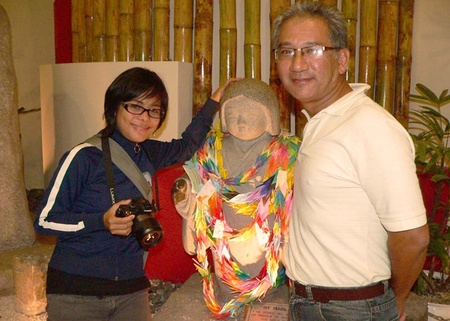Part 2 >>
The Nikkei in Peru
Kaori is impressed by the way the Nikkei community in Peru has preserved its identity. “What I really find admirable is that there is a place (Japanese-Peruvian Cultural Center) that seeks to maintain the Nikkei identity in some fashion; there’s no reason to analyze something which is always present: What it means to be Nikkei. Even offering a class on taiko is important enough. It’s like a down payment of sorts; if afterward you want to deepen your identity or your [knowledge] of history, it is a separate thing,” she affirms.
The Nikkei in Venezuela are much more integrated than those in Peru. The Nikkei community in Peru “is much more closed or not as integrated like ours. In Venezuela we are very mixed, very much integrated.”
What is better? To integrate or close yourself off? Perhaps there is middle ground. “I believe that we should not close ourselves off, but yes, we should maintain our culture,” Kaori responds.
Shock in Japan
Many Peruvian Nikkei discovered while visiting Japan that they are Peruvian rather than Japanese. For Kaori, who has traveled to her ancestral home on a couple of occasions, something similar happened to her. “You discover that you are not part of Japan; I felt much more Latin American from the very first time that I arrived in Japan,” she notes. “If you go to Japan you are a gaijin—not even a Nikkei,” Kaori emphasizes.
Japan surprised Kaori. “It was a very big shock. Tokyo is a city that constantly orders you around. It tells you ‘Walk here,’ ‘don’t forget your umbrella when you head to the subway’…when you open the freezer at the supermarket, someone is telling you what you are going to find. This has made everyone automated; they don’t even watch each other because they enter the subway and fall asleep. For me, Tokyo was a cross between a little bit of nature and an overwhelming city,” she explains.
Epilogue
After visiting Japan and Peru, Kaori is in the home stretch of finishing her documentary, Nikkei. It will follow three historical arcs: the first, from the Meiji Restoration to 1921, the year her grandfather left Japan, which helps explain the motives for Japanese emigration to the Americas; the second story arc follows Rinzo in Peru through 1939; and the third and final arc follows Rinzo from Peru to Venezuela, ending in the year 1956.
In the process of making Nikkei, Kaori has come to discover things about herself, her family, and the history of Japanese immigration. The same thing hapened to the Nikkei when they watched the documentary and saw that the history of the Yonekura family was their history too.
* * *
Profile
Kaori Flores Yonekura has been making documentaries for about eleven years. She especially likes to cover such topics as Latin American culture, human rights, peace, and the indigenous movement. She worked with the filmmaker Hugo Shinki in Peru.
* This article is made possible by an agreement between the Japanese Peruvian Association and the Discover Nikkei Project. It first appeared in the journal Kaikan, volume 47, July 2010.
© 2010 Asociación Peruano Japonesa y Enrique Higa Sakuda / © 2010 Fotos: Asociación Peruano Japonesa y Kaori Flores Yonekura












